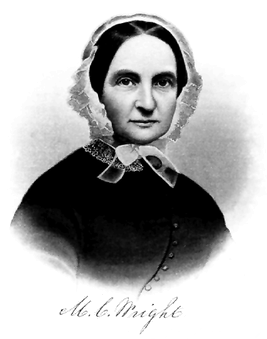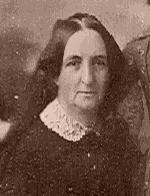
Martha Coffin Wright
Encyclopedia

Declaration of Sentiments
The Declaration of Sentiments, also known as the Declaration of Rights and Sentiments, is a document signed in 1848 by 68 women and 32 men, 100 out of some 300 attendees at the first women's rights convention, in Seneca Falls, New York, now known as the Seneca Falls Convention...
.
Early life
Martha Coffin was born in Boston, Massachusetts on Christmas day 1806, the youngest child of Anna Folger and Thomas Coffin, a merchant and former NantucketNantucket, Massachusetts
Nantucket is an island south of Cape Cod, Massachusetts, in the United States. Together with the small islands of Tuckernuck and Muskeget, it constitutes the town of Nantucket, Massachusetts, and the coterminous Nantucket County, which are consolidated. Part of the town is designated the Nantucket...
ship captain. After the Coffin family moved to Philadelphia
Philadelphia, Pennsylvania
Philadelphia is the largest city in the Commonwealth of Pennsylvania and the county seat of Philadelphia County, with which it is coterminous. The city is located in the Northeastern United States along the Delaware and Schuylkill rivers. It is the fifth-most-populous city in the United States,...
, Martha was educated at Quaker schools.
Martha married Peter Pelham of Kentucky in 1824 and moved with him to a frontier fort at Tampa Bay, Florida
Tampa, Florida
Tampa is a city in the U.S. state of Florida. It serves as the county seat for Hillsborough County. Tampa is located on the west coast of Florida. The population of Tampa in 2010 was 335,709....
. They had a daughter. Peter died in 1826, leaving Martha a nineteen-year-old widow with an infant child. She moved to upstate New York to teach painting and writing at a Quaker school for girls. She married a young law student named David Wright and had six more children.
Seneca Falls Convention
Martha's older sister Lucretia Coffin MottLucretia Mott
Lucretia Coffin Mott was an American Quaker, abolitionist, social reformer, and proponent of women's rights.- Early life and education:...
was a prominent Quaker preacher. In July 1848, she visited Martha's home in Auburn, New York
Auburn, New York
Auburn is a city in Cayuga County, New York, United States of America. As of the 2010 census, the city had a population of 27,687...
. During that visit, Martha and Lucretia met with Elizabeth Cady Stanton
Elizabeth Cady Stanton
Elizabeth Cady Stanton was an American social activist, abolitionist, and leading figure of the early woman's movement...
and two other women and decided to hold a convention in nearby Seneca Falls, New York
Seneca Falls (village), New York
Seneca Falls is a village in Seneca County, New York, United States. The population was 6,861 at the 2000 census. The village is in the Town of Seneca Falls, east of Geneva, New York. On March 16, 2010, village residents voted to dissolve the village, a move that would take effect at the end of 2011...
, to discuss the need for greater rights for women.
The importance of the Seneca Falls Convention
Seneca Falls Convention
The Seneca Falls Convention was an early and influential women's rights convention held in Seneca Falls, New York, July 19–20, 1848. It was organized by local New York women upon the occasion of a visit by Boston-based Lucretia Mott, a Quaker famous for her speaking ability, a skill rarely...
was recognized by Congress in 1980 with the creation of the Women's Rights National Historical Park
Women's Rights National Historical Park
Women's Rights National Historical Park was established in 1980, and covers a total of 6.83 acres of land in Seneca Falls and nearby Waterloo, New York....
at the site, administered by the National Park Service
National Park Service
The National Park Service is the U.S. federal agency that manages all national parks, many national monuments, and other conservation and historical properties with various title designations...
. The Park's Visitor Center today features a group of life-size bronze statues to honor the women and men who in 1848 initiated the organized movement for women's rights and woman suffrage. Her statue shows her, as she was then, visibly pregnant. In 2005, the park featured a display about the relationship between Lucretia and Martha. In 2008, the park featured a display focused on Martha.
Women's rights and abolitionism

Seneca Falls Convention
The Seneca Falls Convention was an early and influential women's rights convention held in Seneca Falls, New York, July 19–20, 1848. It was organized by local New York women upon the occasion of a visit by Boston-based Lucretia Mott, a Quaker famous for her speaking ability, a skill rarely...
Martha Wright participated in a number of state conventions and the annual National Women's Rights Convention
National Women's Rights Convention
The National Women's Rights Convention was an annual series of meetings that increased the visibility of the early women's rights movement in the United States. First held in 1850 in Worcester, Massachusetts, the National Women's Rights Convention combined both male and female leadership, and...
s in various capacities, often serving as President. She was also active in the abolition movement. The arguments for women's rights had much in common with the arguments for abolition. With her sister Lucretia, Martha attended the founding meeting of the American Anti-Slavery Society in Philadelphia in 1833.
Underground Railroad
Martha's home in Auburn, New YorkAuburn, New York
Auburn is a city in Cayuga County, New York, United States of America. As of the 2010 census, the city had a population of 27,687...
, was part of the Underground Railroad
Underground Railroad
The Underground Railroad was an informal network of secret routes and safe houses used by 19th-century black slaves in the United States to escape to free states and Canada with the aid of abolitionists and allies who were sympathetic to their cause. The term is also applied to the abolitionists,...
where she harbored fugitive slaves. She became a close friend and supporter of Harriet Tubman
Harriet Tubman
Harriet Tubman Harriet Tubman Harriet Tubman (born Araminta Harriet Ross; (1820 – 1913) was an African-American abolitionist, humanitarian, and Union spy during the American Civil War. After escaping from slavery, into which she was born, she made thirteen missions to rescue more than 70 slaves...
.
Ellen Wright
Martha's daughter Ellen Wright (1840-1931) was an advocate of women's rights, especially woman suffrage. In 1864, she married William Lloyd Garrison, Jr. (1838-1909), a prominent advocate of the single tax, free trade, woman's suffrage, and of the repeal of the Chinese Exclusion Act. William was the son of abolitionist William Lloyd GarrisonWilliam Lloyd Garrison
William Lloyd Garrison was a prominent American abolitionist, journalist, and social reformer. He is best known as the editor of the abolitionist newspaper The Liberator, and as one of the founders of the American Anti-Slavery Society, he promoted "immediate emancipation" of slaves in the United...
. Ellen and William's daughter, Eleanor Garrison (1880-1974), worked for the National American Woman Suffrage Association
National American Woman Suffrage Association
The National American Woman Suffrage Association was an American women's rights organization formed in May 1890 as a unification of the National Woman Suffrage Association and the American Woman Suffrage Association...
.
Recognition
On October 9, 2007 House resolution 588 entitled "Recognizing Martha Coffin Wright on the 200th anniversary of her birth and her induction into the National Women's Hall of Fame" passed in the U.S. House of Representatives.External links
- UMass Biography of Martha Coffin Wright
- Biography of Martha Coffin Wright
- Smith College page on the Wright-Garrison Families including a photo of Martha in middle of page
- Women's Letters, 2005, Dial Press, Pages 165-8, Letter from Martha Coffin Wright to Lucretia Mott
- Video on Martha Wright
- House resolution 588 recognizing her

